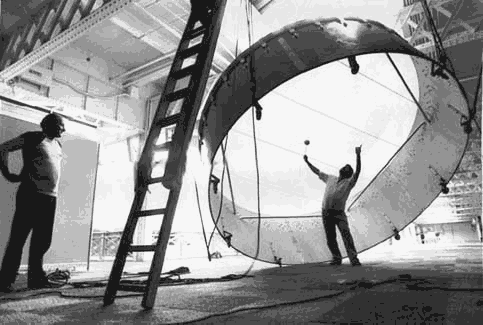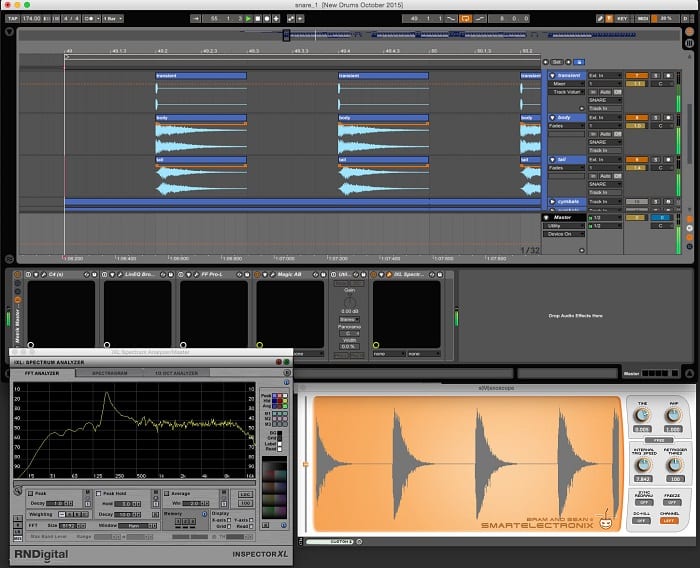It’s the ultimate whip crack from the ringmaster kickdrum.
It’s the lightning yin to the kickdrum’s thunderous yang.
It can be made out of almost any sound or sample
At 174BPM, it occurs every 0.35 seconds.
In internet language the best ones are frequently preceded by the word ‘dat’ and succeeded by the word ‘tho’
It is, of course, the snare. The essential ingredient that can turn a regular rolling groove into an attention-grabbing banger, without it drum & bass would be a dull place. But what makes the perfect snare? And who makes the perfect snare?
Simple questions to ask, not so simple to answer. Every artist has their own technique and treatment (as proved by Methlab’s recent free #DatSnareTho samplepack), and their own personal perspective.
Read on and sort out your transients from your tails with advice, reflections and deep theories from Billain, Calyx & TeeBee, Current Value, Cyantific, Delta Heavy, Krakota, Loadstar, Maztek, Metrik, Misanthrop, Phace, Rene LaVice, ShockOne and Drumsound & Bassline Smith who went in on such a level they’ve potted the history of snares in drum & bass.
Pro-tip: Bookmark this and read it when you’ve got time. This is the snare gospel with priceless information for any budding artists and some fantastic insight for all D&B fans who want to know more about why this genre sounds and punches the way it does.
First, a little history in a jungle context from Drumsound & Bassline Smith….
“Over the years, with regards to D&B, musical trends and advances in technology/processes have dictated what’s deemed ‘perfect’. In the early jungle days producers used chopped, processed and pitched up funk breaks which meant that the kick and the snare were predominately quite thin but left plenty of room for the heavy booming bassline.
“Then, as it progressed into drum and bass in the mid 90s, drum machines were being used more and the music was becoming lead by the two-step beat putting more emphasis on having a prominent phat kick and snare like Dillinja in Hard Noize.
“By the early 2000s the funk breaks were being cut at 200-500hz and substitute sample and heavily processed kicks and snares were added to make the breaks even thicker. Like what we did on Odyssey in 2004. Then, particularly with the introduction of sample packs (like Vengeance ), people started to create purely kick and snare lead tracks where the snare would be tuned, layered and processed with claps etc to say 200hz (Timewarp by Subfocus was a great example of this method)
“Now it’s gone full circle as many artists are using software such as Superior Drummer to make brand new breaks from scratch using all of the processing techniques we have learnt over the last 20 years combined with the developments in software to ensure the drums have all the qualities of a funk break but with the strength and quality that’s necessary in a modern D&B tune.”
History lesson over, back to the future: Here are 14 professional perspectives on serious snare science….
Billain
What makes the perfect snare?
Pretty much anything that sounds strong as an opposition to the kick and bass coalition and has an audible snare signature or feeling… For every track there are only a few good ways that really work.
Who makes the perfect snare?
Buddy Rich in terms of technique. In terms of size? There was one in Ireland in 2001; Brian Fleming’s Millennium Drum for the Millennium Drum Carnival. It stood 308 inches in diameter and 75 inches deep.

Calyx & Teebee
What makes the perfect snare?
This question is 100% up to the individual. Some may prefer a natural-sounding snare while others are into a more digital or synthetic sound. For us, it has to have a good thwack to it with a relatively hard transient to hit it off.
But the tail can be anything from short to spikey and resonant. We like the top end of the snare to sit quite wide in the mix and the overheads and room to slightly duck away at the impact of the first transient, just to get that chest oompppff prominent on impact .
Who makes the perfect snare?
This has changed over time for us. It used to be Photek and Dillinja. Now it is maybe Mefjus . But again, there are other tracks trickling through with fantastic sounding snares week in week out. That snare in Mefjus’s Ivy Lab remix on Critical is very special though.
Current Value
What makes the perfect snare?
In the mix: the right tuning, the right leveling in the mix combined with the right length and timbre.
In general: The perfect snare (if that exists) lives from well-proportioned timing components…
Transient (preferably focussing on 1 kHz), the base frequency that “swings in and out” (Frequency can vary from 130Hz to up in the 5- hundreds) and the “rattle” giving it the noise carpet.
Who makes the perfect snare?
Someone who knows how to do the above!
Cyantific
What makes the perfect snare?
Snares can come in a lot of different shapes and sizes – claps, rim shots, big snares, short snappy ones etc. but for me what they need is character. For example, I really like layering a live snare with a nice decay on it to bring a shorter snare to life. The important thing is to have a nice attack on it and if there’s low end, you really want that to hit quickly.
Who makes the perfect snare?
I’m a big fan of Sub Focus snares. He gets the nicest attack, it sounds really pinched but in a good way. The result is something that cuts through the mix, but sounds almost delicate. A good example of this is You Make It Better feat. Culture Shock & TC.
Delta Heavy
What makes the perfect snare?
One thing that snares all have in common in bass music is providing energy and character. They are the main feature of the drums and will often be a defining feature of a tune, much more so than house or techno where the kick is everything.
A good snare needs punch, weight and vibrancy in the character that makes a tune feel alive. Snares are often sourced from breaks or real drum samples as they provide the character and are then layered with synthetic low end snares to provide weight and top airy white noise layers which make the drums feel big and bright and glue them into the rest of the tune.
Snares with really different character have been interesting to us recently. Sounds that wouldn’t normally be used in this way are making music sound fresh like Jack Ü’s Take You There which uses a pitch enveloped wooden block-esq sound. We used a cowbell for the snare in our recent tune Apathy.
Who makes the perfect snare?
For us, Noisia, Sub Focus, Knife Party and Flume all nail the snares in their tunes 100% of the time. The ability to make a snare feel effortless yet be so powerful and have character is an art. They probably consume about 30% of the time it takes to make an entire tune for us!
Drumsound & Bassline Smith
We always have tried to keep a funky organic element by using all or part of a break underneath and choosing an appropriate kick and snare to complement it. We always want a snare that has good weight or thump tuned to the song’s key, if possible, by using a low bump from a synth or like a Roland 909 snare at say 200-250hz with a good snap created using a clap or a rim shot maybe with a synthetic crash or a blast of enveloped white noise for a bit of air. We also try to incorporate an acoustic snare to give it colour and maintain a natural feel. We then blend the electronic bits and the acoustic bits all together with EQ, reverb, gating, compression and saturation to create something that organically fits with the rest of the drums. Transient design is important as this helps the drums cut through the mix and spatial design also helps to be considered to give the drums their own ‘space’ within the mix. Creating a snare from scratch is an art-form in itself but there are no wrong answers, as long as it works within the realms of your project and does what you want it to do.
Who makes the perfect snare?
Overall, of all the snares we have ever heard or used it’s fair to say that the Amen snare is our favourite. It’s versatility, presence and tone is, without doubt, unsurpassed and that’s why it will always be number one in our book. Well, until someone can recreate something better…
Krakota
What makes the perfect snare?
There are a few points to mention here, it’s definitely not a ‘one size fits all’ approach.
Context: The snare hit (which may not always be an actual snare sound) needs to work in context with the tune. A smooth roller may not work with a huge 200hz transient, but that style of snare might sit more at home in something more tear-out. This isn’t always the case, but you get the idea.
Layering: Drum & bass is notorious for having many layers of samples, the snare is one where producers go wild, but it’s easy to over-cook it. Usually you’ll have one initial hit or ‘transient’ layer that sounds for a few milliseconds at the very beginning of a hit, after there’s often a host of other sounds to fill the mid/tops, such as a clap/percussive/wood sound which will be processed accordingly with EQ/Distortion/Reverb. White noise is also popular to fill out the highs.
Imaging: Often over-looked, if you want it to really stand out the stereo image needs to be looked at. As a generalisation the lower end of the snare will be mono whilst the higher up the frequency range you go the more stereo width you can use. A good way of adding this to the snare is by layering with live sounds where there’s a bit of room reverb. Using a drum kit VST which emulates live micing, or simply using a reverb.
Compression: Compression is a key part of getting your snare elements to gel well so it sits correctly within the drum mix. Again, it’s easy to over-cook it. No compression and it can sound harsh and un-finished, too much and it’s flat and lifeless.
Who makes the perfect snare?
Nobody’s perfect, but these two are worth a mention!
Loadstar
What makes the perfect snare?
Making snare drums is one of the trickiest things to get right. Yeah it’s easy to boost 200Hz and make your snare sound like a wet fish on an ironing board. But to get snares sounding phat and punchy whilst retaining character and transients is a different thing all together. In terms of making the perfect snare we tend to adopt a less is more approach. Finding good samples in the first place limits the need to layer and layer lots of average sounds and also means you need to do less processing to achieve the sound you’re after.
Who makes the perfect snare?
Noisia. Their beats always sound unique, phat and punchy. Go check out their recent track Dead limit as a perfect example of how drums and snares should sound with in drum and bass.
Maztek
What makes the perfect snare?
A combination of punch, transient and orgasm
Who makes the perfect snare?
Everyone who spends more than one week working on it.
Metrik
What makes the perfect snare?
I’ve often been asked about my snares over the years so it’s nice to get the opportunity to shed a bit of light on how I think about them (I tend to think about them a lot!)
At 174bpm the snare occurs every 0.35 seconds so, by a large degree, dictates much of the character and dynamic of the track. For this reason, it’s important to address the frequency balance to avoid offending our sensitive eardrums (particularly on a powerful club sound system) and to provide the right amount of punch to convey the impact of the music. Conversely, it’s important to consider the snare’s aesthetic to ensure it complements the style of the music as well as the drum track as a whole. I like to think of my snares as three main components:
Transient: The moment the stick hits the skin of the drum, the initial attack. I generally don’t have too much low content here and is fairly flat from the mids to the highs. You’d be surprised at how much sonic information in relation to the character is delivered in these first few milliseconds. It’s important to consider the length of this layer, too short and your snare will sound synthetic, too long and you will lose the perceived “punch”.
Body: The body of a snare sits at 200hz above the kick at 100hz. I tend to mix the low frequencies of the snare and kick equally to -10db. Be careful not to isolate 200hz too much as the lower mids are crucial for providing warmth and realism. I often boost around 500hz which can help distract from that classic “too much 200hz” vibe. Sometimes adding a very subtle low-passed acoustic live snare layer here can add a nice aggressive feel and help glue things together.
Tail: This is where your high frequency content sits from the upper mids to the top end (1000hz – 10khz). The release of this can be extremely crucial to the “roll” of the drums. It’s important to keep your top end nice and controlled – too much top in this region can make your overall drum mix irritating. Lately, I’ve been making this decay very tight whereas in the past I’ve gone for a very splashy top, layering with white noise and cymbals. It’s popular at the moment to add a peak at 1.5khz to emphasise the character of the upper mids (check out Wilkinson & Culture Shock). This can really help pull the snare out of the mix in an area otherwise dominated by musical parts.
The perceived “punch” of the snare is achieved by the dynamic relationship between these elements. For example, a slight fade on the tail can give the transient more emphasis. It’s a very careful balance. Sidechain compressing the body and / or the tail to the transient with a very fast release can also give nice results. I prefer to use volume envelopes to sculpt the dynamics as this gives you more control. Ultimately, your snare needs to sound convincing – if you are finding things are sounding too artificial, try adding some live drum layers to give a more “humanised” feel.
Here is a screengrab of a snare I’m working on in a current project where you can see the three individual layers. It can be tempting to solo the snare and work on it without any context so including the rest of the drums in the mix can help a lot. It’s also useful to include the bass and synths as musical elements can be highly suggestive to the character of the snare.

Finally, experiment. Sometimes seemingly unorthodox and extreme techniques can lead to great results. Once you’ve established your layers, liberally apply plugins (compressors, saturators, distortions, reverbs, phasers etc.) and see what comes out on the other side. Hopefully you will arrive at something which characterises your productions.
Who makes the perfect snare?
I’ve always been impressed with Rob Swire’s snares and his drum engineering in general. He achieves a pleasing level of punch without sounding offensive yet maintaining a realistic organic feel. I’ve often tried to emulate this aesthetic with my own drums; heavy hitting with soft transients and glossy tops. Writing an article on snare drums wouldn’t be complete without mentioning Sub Focus and Culture Shock who also have some of the best snares in the game IMO!
Misanthrop
What makes the perfect snare?
The good thing is that the possibilities for snares are endless. For me the perfect snare is the snare I´ve never heard before!
In my opinion it should stick out sonically throughout the mix but also shouldn´t be too prominent at the same time. I think every tune needs its own perfect snare.
Before you create a snare you have to understand how it’s generated.
https://www.youtube.com/watch?v=osFBNLA7woY
The stick hits an enclosed drum hit with a short energy hit, which gives the snare the transient. Shortly after the main body and pitch of the snare is generated by that same hit, followed by a rattle, which produces a noisy tail. This rattle also defines the character of the drum hit.
Of course this is just a very standard description of it, but if you understand this sequence of actions going on here, you are able to create your own perfect snare very easily. What also really helps to define a certain room feel is to mix your electronic snare with a real snare (Superior Drummer, Addictive Drummer, BFD…) But there are no rules, just your taste and the only limit is your imagination.
So go create an arsenal of transients, bodies and tails and combine them for instant snare fun.
Who makes the perfect snare?
The producer that understood the principles of how a snare works and is able to put it into the right mix environment! I can´t really name a specific artist here, there are so many great producers out there. The one band that probably influenced me the most (snarewise) and still impresses me, are the snares of Chic engineered by Bob Clearmountain!
https://www.youtube.com/watch?v=CycTQ29ikAA
Phace
What makes the perfect snare?
A clear transient, a beefy/punchy tail, no phasing or bad layering, a clear peak in tone, no worn out break samples
Who makes the perfect snare?
A drum machine 😀
Rene Lavice
What makes the perfect snare?
The perfect snare is anything that fits the vibe of a track perfectly. With that in mind, you can make a snare out of literally anything. I made the snare for Bill Folderson by flicking a USA 1 dollar bill into a condenser mic by pulling it at both ends. I did it just to hear what it would sound like and found out that when recorded into a microphone at close range a lot of the low end frequencies were more audible and fell into the same range as most snare drums. I layered it with an actual hi-hat cymbal to give it some grit and then used it in the song. Most people didn’t believe me because it sounds so convincing as a snare drum, but that’s why the song is called Bill Folderson.
That snare sound sat really well in the track. If the track had a different concept, if it was more dissonant and random, then maybe smashing two garbage cans together would work. There is no perfect snare. The perfect snare is whatever works with the track.
Who makes the perfect snare?
Current Value has some very cool snare sounds. In most people’s productions they might not sound that good, but because of the unique style of his tracks they slice through the mix in a really cool way.
ShockOne
What makes the perfect snare?
I don’t think there is such a thing as the perfect snare. It’s all a matter of context and things working relative to each other. For me the people whose snares I always find myself analysing or obsessing over are guys who know how to make drums sit in a mix well, or furthermore, who are just great mix engineers. So, it’s not necessarily the snare itself, but more how it’s fitting into the bigger picture that’s making it sound great.
For me, it’s quite often of a case of the less the information the better in a snare sound. The less room it takes up in a mix, the easier it is to tuck it in and do its job. That is to say, you want energy and information in the “right” areas of the frequency spectrum of the sound, and of course that’s totally dependent on the tune, the mix, the other drums in the kit etc. So again you come back to looking at how the drum fits into the bigger picture. You can easily have a pretty average sounding snare that is working so well in a mix that it sounds fantastic when the whole mix is playing, and conversely you can easily have a snare that sounds fantastic/huge/rips your face off when played alone, but won’t play nicely with the rest of the elements in a mix.
I think in drum and bass/bass music/electronic music production we’re often guilty of micro-managing in our approach to a mixdown. We spend so much time concentrating on individual elements being amazing, be it a snare, or a bass patch, or a break and then we go, “well all these elements sound fantastic on their own, so if I put them all together, I should have a crazy hot mixdown!” But I’ve found this is not how sound works. The further down the audio engineering and production rabbit hole I fall, the more I realise that it’s wise to stand back and take the wide angle view of things and not get so caught up in the Tetris blocks of a mix.
Who makes the perfect snare?
Guys for me who make their snares work impeccably are Culture Shock, Metrik, Kill The Noise, Sub Focus and Break to name a few. There is always such an element of class in the way they mix their snares and drums in general, there is energy, but it’s controlled. Some mixes are darker, some are brighter, some are squashed, some are more dynamic, but the mix down is always working as a whole and has a sense of real coherence, and most importantly the mix down is serving the song itself and whatever that song is trying to express. That after all is what it’s all about right? *apologies for slight tangent* *end rant*
Need more snares? Methlab are giving away stacks for free


